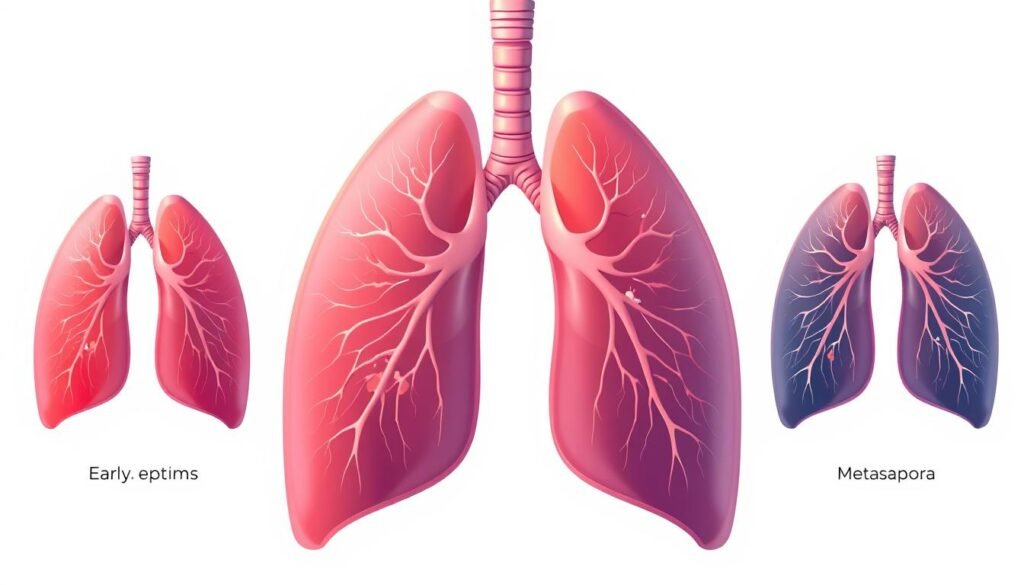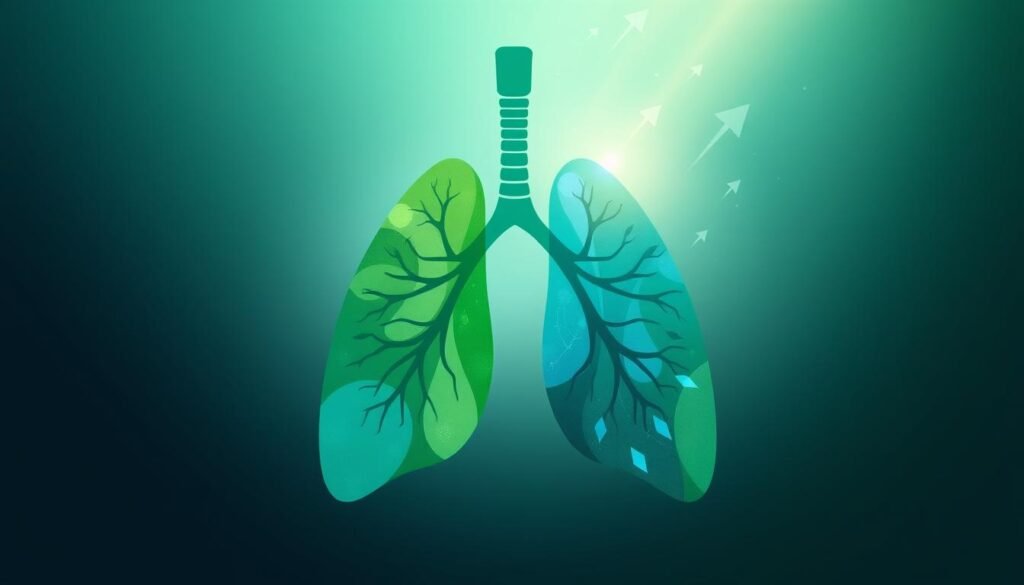Lung cancer makes up about 13% of all new cancer cases in the U.S. In 2020, it’s expected there will be 228,820 new cases. This makes lung cancer the top cause of cancer deaths globally. It’s key to know the different types and warning signs of lung cancer. This knowledge helps catch it early on. In this article, we look at the most common lung cancers and their categories. We’ll talk about why it’s vital to know the signs, so you can take steps to protect your health.
Key Takeaways
- Lung cancer is the leading cause of cancer deaths globally.
- Approximately 85% of lung cancer cases are classified as non-small cell lung cancer (NSCLC).
- Recognizing early warning signs can greatly improve treatment outcomes.
- Symptoms may include persistent coughing and shortness of breath.
- Several risk factors, including smoking and environmental exposure, can increase the likelihood of developing lung cancer.
- Early detection and awareness of lung cancer types are vital for effective management and treatment.
Overview of Lung Cancer
Lung cancer starts in the lungs’ cells and grows uncontrollably. Often, there are no signs until it’s very advanced. Early detection is key. Smoking is the top cause, but non-smokers can get lung cancer too. It’s more common in those who use tobacco.
Lung cancer comes in two main types: NSCLC and SCLC. NSCLC makes up about 80% to 85% of cases. The most common NSCLC is adenocarcinoma. Smoking is closely linked to squamous cell carcinoma. Large cell carcinoma is another NSCLC type that grows fast, making treatment hard.
SCLC, linked to smoking, is about 10% to 15% of lung cancers. A few cases are carcinoid tumors, under 5%, growing slowly. This shows lung cancer has many forms, requiring specific treatment plans.
About 5 percent of lung cancers are mesothelioma. It’s important to know some chest diseases aren’t primary lung cancers. Diseases like lymphomas and sarcomas appear in the chest but are different. A deep understanding is needed for effective lung cancer prevention and treatment.
Understanding Lung Cancer Types
Lung cancer falls into two main types: non-small cell lung cancer and small cell lung cancer. Knowing the difference between them is key for proper diagnosis and treatment.
Non-Small Cell Lung Cancer (NSCLC)
About 80% to 85% of lung cancer cases are non-small cell lung cancer. This group includes different subtypes:
- Adenocarcinoma: Usually in the lungs’ outer areas, it forms in epithelial cells. It makes up roughly 40% of NSCLC cases.
- Squamous Cell Carcinoma: Found close to the bronchus, it accounts for about 30% of NSCLC cases.
- Large Cell Carcinoma: This type can appear anywhere in the lung. It spreads faster than other types.
In some instances, Pancoast tumors, a unique NSCLC type, develop at the top of the lungs. They often need chemotherapy, radiation, and surgery to treat.
Small Cell Lung Cancer (SCLC)
Small cell lung cancer makes up 10% to 15% of all lung cancer cases. It’s closely linked to heavy smoking. There are two main kinds:
- Small Cell Carcinoma
- Mixed Small Cell/Large Cell Cancer
This cancer type is marked by quick growth and early spread. It’s especially tough due to its aggressive nature and early spreading.
Most Common Lung Cancer: Statistics and Prevalence
Lung cancer is a major health issue, shown through many statistics and trends. In the U.S., it’s diagnosed in over 230,000 people yearly. It’s also the top cause of cancer deaths.
About 80% to 85% of lung cancers are non-small cell lung cancer (NSCLC). Small cell lung cancer (SCLC) makes up 10% to 15%. This shows how important it is to know about different lung cancer types. It affects how they’re treated and their outcomes.
Most people with lung cancer are around 70 years old. It mainly hits those 65 or older. Lung cancer is the second most common cancer in U.S. men and women, after skin cancer.
In 2024, we expect around 234,580 new lung cancer cases. Sadly, about 125,070 people will die from it. Men have a 1 in 16 chance of getting lung cancer, and women have a 1 in 17 chance. This includes smokers and non-smokers.
Black men are 12% more likely than white men to get lung cancer. But, black women are 16% less likely than white women to get it.
Lung cancer rates have slowly been dropping, especially in men over the last few years. Women’s rates have also decreased in the last decade. Still, lung cancer is a big health issue. We need more awareness and efforts for early detection and prevention.
Key Lung Cancer Symptoms to Recognize
Knowing lung cancer symptoms is key for early finding. Spotting changes in health can guide to quick doctor visits. It is vital to know these signs, as they often show up later in lung cancer.
Persistent Coughing
A serious lung cancer symptom is constant coughing. This cough usually gets worse over time. It can start as a small bother but can turn into a big problem. If you keep coughing, especially with blood or feeling very tired, see a doctor.
Chest Pain and Shortness of Breath
Chest pain in lung cancer is a serious warning of the disease getting worse. This pain happens more when you take deep breaths, laugh, or cough. Feeling out of breath often comes with chest pain. This means you should get medical help fast. To learn more about lung cancer signs, check this resource.

Lung Cancer Warning Signs: What to Look For
Knowing the warning signs of lung cancer is key to catching it early. Early signs are subtle but important. They give us a hint before things get worse. Look out for these early warnings of lung cancer:
- Unexplained weight loss
- Fatigue
- Wheezing
- Recurring respiratory infections, such as pneumonia or bronchitis
A cough that lasts more than eight weeks should concern you. This symptom often means the disease is in its advanced stages. Lung cancer’s symptoms depend on its type. Non-small cell lung cancers typically grow slowly. On the other hand, small cell lung cancer symptoms get worse quickly as it spreads.
Other symptoms to watch for include:
- Coughing up blood, even in small amounts
- Shortness of breath caused by blocked airways
- Chest pain that gets worse with deep breaths or coughs
- Hoarseness from tumors on the vocal cords
People who’ve smoked for years need to be extra careful. Spotting lung cancer warning signs early and getting help can make a big difference in treatment success.
Lung Cancer Stages: Understanding Progression
Lung cancer stages are key in figuring out how the cancer grows. Understanding which stage the cancer is at helps doctors find the right treatment. It also lets people know what to expect in the future. The stages go from I to IV, showing how much the cancer has spread.
Stage I to Stage IV Explanation
Knowing each stage well is crucial for both patients and their caregivers. Let’s look at what lung cancer stages mean:
| Stage | Description | Characteristics |
|---|---|---|
| Stage 0 | Carcinoma in-situ | Early-stage, localized; no spread beyond the lung lining |
| Stage I | Localized tumor | Sub-stages I-A and I-B; cancer has not reached lymph nodes |
| Stage II | Larger tumors | Includes IIA and IIB; possible spread to nearby lymph nodes |
| Stage III | Locally advanced | Common lymph node involvement; categorized as IIIA, IIIB, or IIIC |
| Stage IV | Advanced disease | Metastasis to lung lining or distant organs, such as bones or brain |
Small Cell Lung Cancer (SCLC) has its own staging system, known as limited or extensive. Limited-stage SCLC means cancer is only in one lung and may involve lymph nodes. Extensive-stage SCLC shows the cancer has spread more, reaching other areas or organs.
Properly staging lung cancer is crucial for picking the right treatment. It also helps with setting the expectations for patients. Knowing about lung cancer stages helps in making informed decisions for care.

Lung Cancer Causes and Risk Factors
Lung cancer is tied to various factors that increase risk. It’s key to understand these to try and prevent it. Knowing the main reasons for lung cancer can lead to steps that cut down on risk.
Smoking and Secondhand Smoke
Smoking is the top cause of lung cancer, tied to about 90% of cases. It causes around 80% of lung cancer deaths in the U.S. Secondhand smoke is also a big risk. It’s the third leading cause of lung cancer. Being around smoke even if you’re not the one smoking can increase your lung cancer risk. But, if people stop smoking, the risk drops a lot. This could really help public health.
Environmental Factors and Genetics
Many environmental factors increase lung risk. Radon gas is the second biggest cause, found in many homes. Workers exposed to asbestos and diesel exhaust face big risks too. If lung cancer runs in your family, your risk might be higher. Things like arsenic, cadmium, and nickel, plus pollution from cars, add to the risk.
For more details on lung cancer risks, check out the CDC’s resource.
| Risk Factor | Details |
|---|---|
| Smoking | Accounts for 80% of lung cancer deaths; primary cause. |
| Secondhand Smoke | Third leading cause; affects non-smokers living with smokers. |
| Radon Exposure | Second leading cause; found in homes, especially in certain regions. |
| Occupational Exposure | Exposures to asbestos, diesel exhaust, and other carcinogens. |
| Genetics | History of lung cancer in the family increases overall risk. |
| Environmental toxins | Exposure to chemicals like arsenic and particulate pollution. |
Lung Cancer Screening: Importance of Early Detection
Lung cancer screening is crucial for catching the disease early. This improves survival rates and the success of treatments. In the United States, lung cancer is the top cause of death from cancer. The American Cancer Society recommends yearly screening for people aged 50 to 80. These people should have a history of smoking equivalent to at least 20 pack-years. A pack-year means smoking a pack a day for a year.
LDCT scans are a gentler option that uses less radiation than regular CT scans. They are essential for those at high risk since lung cancer signs often appear late. This delay can make diagnosis and treatment hard. With regular checks, doctors can find lung cancer early. This makes treatment more likely to work, boosting survival chances.
Still, only about 6% of people who should get screened actually do. This low number shows we need more awareness and better access to screening sites. These sites need skilled staff ready to handle any findings during screening.
Lung cancer screening’s big benefit is finding cancer early, even though it’s not perfect and might have false alarms. Stop smoking to lower lung cancer risks further. Screening and healthy habits are key to better health.
| Aspect | Details |
|---|---|
| Recommended Age for Screening | 50 to 80 years |
| Smoking History Requirement | At least 20 pack-years |
| Screening Method | Low-Dose Computed Tomography (LDCT) |
| Radiation Exposure | Low exposure compared to standard CT scans |
| Annual Screening Recommendation | Yes |
| Current Screening Rate | Approximately 6% |
| Potential False Positives | Yes, possible occurrence |
| Effectiveness of Screening | Increases chances of early detection and successful treatment |
Available Lung Cancer Treatments
Knowing the different treatments for lung cancer is key for patients and their families. Treatment plans depend on the cancer type and stage. Surgery for lung cancer is often the first step for early-stage non-small cell lung cancer (NSCLC). This may mean removing part or all of the lung. For advanced stages, a mix of treatments is used.
Surgery and Radiation Therapy
Surgery can be the initial treatment for lung cancer, especially when the tumor hasn’t spread. Radiation therapy may also be used, either before or after surgery. It aims to destroy any remaining cancer cells. Types of surgical treatments include:
- Segmental or wedge resection
- Lobectomy
- Pneumonectomy
- Sleeve resection
Chemotherapy and Targeted Therapy
Chemotherapy is crucial for many lung cancer treatments. It may follow surgery to get rid of any cancer cells left or be used alone when surgery isn’t an option. Chemotherapy stops cancer cells from growing and reproducing. It’s often paired with radiation therapy for better results.
Targeted therapies offer personalized treatment, especially for NSCLC patients. Treatments like crizotinib and erlotinib target specific cancer cell markers. These advanced therapies improve patient outlooks and may increase survival rates.
| Treatment Type | Primary Purpose | Suitability |
|---|---|---|
| Surgery | Remove tumors | Early-stage NSCLC |
| Radiation Therapy | Target remaining cancer cells | Post-surgery or advanced cases |
| Chemotherapy | Kill remaining cancer cells | Post-operative or advanced lung cancer |
| Targeted Therapy | Attack specific cancer cell features | Specific NSCLC types |
Lung Cancer Survival Rates: What to Expect
Lung cancer survival rates vary a lot. They depend on the cancer’s stage when found and the treatment given. Knowing these stats is key for a clear lung cancer prognosis. It helps bring hope after a diagnosis. For instance, around 65 out of 100 people with stage 1 lung cancer live for 5 years or more.
However, the survival rate falls to about 40% for stage 2. It then drops to roughly 15% for stage 3. For stage 4, the most advanced stage, the rate is around 5% over five years.
Finding lung cancer early is very important. Around 40% are found at stage IV. Those who find it early often have a much better lung cancer life expectancy. Screening, especially for high-risk groups, can really help find it early. This leads to better lung cancer survival rates.

The table below shows how important staging is for a patient’s journey:
| Stage | 5-Year Survival Rate |
|---|---|
| Stage I | ~65% |
| Stage II | ~40% |
| Stage III | ~15% |
| Stage IV | ~5% |
In the U.S., the five-year lung cancer survival rate is about 19%. These numbers highlight the need for lung cancer symptom awareness. Knowing when to seek medical advice is crucial. People can learn about early lung cancer signs by reading here. Being informed can help patients manage their health better.
Conclusion
It’s key to understand lung cancer for better management and treatment. Lung cancer is the top cause of cancer deaths in the USA. It causes almost as many deaths as prostate, breast, and colon cancers together. Realizing it early can help improve survival rates.
Lung cancer awareness is vital. Regular doctor visits and watching for warning signs are crucial. They help catch the disease early for timely help.
Also, having good resources on lung cancer is very important. They offer support and info to those in need. Educating those at high risk about treatment choices is critical. This includes surgery, radiotherapy, and newer options like immunotherapy. Such advancements are changing patient outcomes for the better.
Starting to advocate for lung cancer awareness is about knowing its signs and risks. Pushing for screenings, especially for those most at risk, can change outcomes a lot. It could even save many lives. Taking action on this health issue means better care for everyone, no matter who they are.
For more details on lung cancer and how to recognize it, check out the World Health Organization and Care Your Lungs.